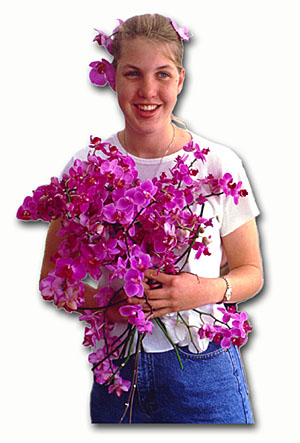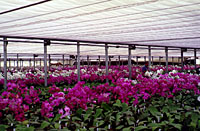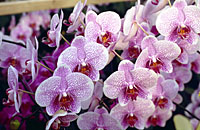Plants available seasonally at HEB Supermarkets,
nurseries, and garden centers in the San Antonio and Austin areas.
There are certain commonly known plants which are
perceived to have such specialized growing conditions that most gardeners
are intimidated into not even trying to grow such plants. The orchid
is just such a plant. Most everyone is enchanted by the perfect, exotic
blooms of orchids. No one can deny the longevity of blooms with a
single bloom furnishing spectacular beauty for as long as four months.
People abandon such plant attributes figuring that growing such a
wonderful plant must require extraordinary care and culture. Actually,
the opposite is true; some orchids require nothing special. Some orchids
can tolerate more abuse than common houseplants and still bloom.
 Orchids compose the largest family of flowering plants in the
world. They occur on every continent except Antarctica so obviously
there should be one that can be easily grown in Texas. In fact, there
are 50 species of orchids plus 2 specific botanical varieties in about
18 genera native to Texas. Many people think that one must have a
fancy greenhouse to produce orchids. There are obvious cold tolerant
orchids since the orchid is the state flower of Minnesota.
Orchids compose the largest family of flowering plants in the
world. They occur on every continent except Antarctica so obviously
there should be one that can be easily grown in Texas. In fact, there
are 50 species of orchids plus 2 specific botanical varieties in about
18 genera native to Texas. Many people think that one must have a
fancy greenhouse to produce orchids. There are obvious cold tolerant
orchids since the orchid is the state flower of Minnesota.
Visual Compendium of All the Different Types of Orchids
Some people think that the soil in Texas is not suitable
for orchid growing. Even if the soil is sorry, the orchid really doesn't
mind since the orchids recommended to be grown in this area are epiphytic.
This means that roots of these orchids grow in and take water from
the air. In fact, standard potting mix will kill these orchids. Orchids
will grow well in most porous, inert mix. Many growers prefer fir
bark to support the orchid roots in growing containers.
Commonly people cause plants to decline because of
neglecting to periodically re-pot. Roots become crowded in pots which
are too small and soon nutrient uptake by expanding roots diminishes
resulting in plant decline. Orchids do not need re- potting as often
as most pot plants. Re-potting is done when the main body of the plant
has reached the edge of the pot in which it is growing and begins
to grow over the side of the pot. This may only occur every three
years or re-potting is necessitated when the potting support material
such as fir bark breaks down. Until that time, aerial roots can actually
grow out of the pot. Clumped orchid plants in small pots are usually
the most spectacular bloom producers.
So if orchid growing is so easy, why don't more people
enjoy the spectacular, exotic blooms of orchids? The answer probably
lies in the selection of the orchid to be grown. The most common orchid
sold in supermarkets is the Cymbidium which is a terrestrial orchid
not suitable for southwest Texas growing conditions. The selling of
such unadapted orchids enable buyers to enjoy the orchid blooms and
then, hopefully, dispose of the plant.
To be a successful orchid grower, you must chose the
variety carefully. The choice as to which is the best orchid for you
is dependent upon sunlight availability and where you want to grow
the plant. The best two choices for this area of Texas are the Phalaenopsis
and the Dendrobium. If you want to grow an orchid indoors in conditions
usually provided for African violets, you should choose the Phalaenopsis.
If you can successfully grow and bloom African violets, you will not
have trouble growing and blooming Phalaenopsis.

Click on image to enlarge.
|
Phalaenopsis, the Moth Orchid, is one of the best orchids for
growing in the home. TEMPERATURES for Phalaenopsis should usually
be above 68 degrees F. at night, and range between 75 and 85 degrees
F. during the day for fast leaf and root growth. Although higher temperatures
force faster vegetative growth, higher humidity and air movement must
accompany higher temperatures, the maximum should not exceed 95 degrees
F.. Night temperatures to 60-65 degrees F. and day temperature not
to exceed 78 degrees F. are desirable for several weeks in the fall
to initiate flower spikes. A sudden, drastic change in temperature
can cause bud drop on plants with buds ready to open.
LIGHT is easy to provide for Phalaenopsis. They
grow easily in a bright window, with little or no direct sun. An east
window is ideal in the home; shaded-south or west windows are acceptable.
Use artificial lighting if available. Do not put plants out-of-doors
in full sun during the summer or they will be scorched quickly.
WATER is especially critical for Phalaenopsis.
Because they have no major water-storage organs other than their leaves,
they must never completely dry out. Water plants thoroughly and do
not water again until nearly dry through the pot. In the heat of summer
in a dry climate, this may be every other day. Water only in the morning
so leaves and the center of the plant are dry by nightfall. This watering
technique prevents rot from occurring on leaves. Use water with low
salt content.
HUMIDITY is important to Phalaenopsis, the recommended
humidity being between 50 and 80 percent. In the home, set the plants
on trays of gravel, partially filled with water, so the pots never
sit in water. Mist the plants during dry weather, in the morning only.
Grouping plants together raises the humidity by keeping the moisture
that plants transpire from being lost too quickly.

Click on image to enlarge.
|
Apply
FERTILIZER on a regular schedule, especially if the weather
is warm, when the plants are most often growing. Orchids need a minimum
of twice a month applications of a balanced fertilizer (20-20-20,
or a similar formulation). Apply fertilizer at full to ½ strength
with every watering; this is best for warm, humid conditions. When
cooler, or under dull conditions, apply fertilizer once every other
watering.
POTTING is best done in late spring, after blooming.
Pot Phalaenopsis plants in a well-draining mix such as fir bark, tree
fern, various types of stone, sphagnum moss, or combinations of these.
Adding 30 percent peat moss to fir bark often results in better growth.
Potting is usually done every 1-3 years. Mature plants can grow in
the same pot until the potting medium starts to decompose, usually
in two years. Root rot occurs if plants remain in a soggy medium.
When mature, a plant may stay in the same pot size for many years,
but must have the medium changed. To re-pot, remove all the old medium
from the roots. Trim soft, rotted roots, and spread the remaining
roots over a handful of medium in the bottom of a new pot. Fill the
rest of the pot with medium, working it through the roots. The junction
of the roots and the stem is at the top of the medium. Wait for a
few days before the first watering. Keep the plant shaded and humid,
but drier in the pot, for several weeks to promote new root growth.



